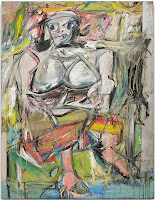 |
| Willem de Kooning, Reclining Man (John F. Kennedy), 1963, oil on paper mounted on fiberboard, 58.4 x 68.6 cm. |
Willem de Kooning was born in the Netherlands on April 14, 1904. He came to the United States in 1926, stowed away in the engine room of a British freighter. He eventually settled in New York where, along with Pollock, he became a leader of the abstract expressionist movement. He’s best known for his expressionist caricatures of women. With their huge eyes, pendulous boobs, and painted mouths, they look crude and vapid. But wonderfully done!
.jpg) |
| Willem de Kooning, Woman, I, 1950-52, oil on canvas, 192.7 x 147.3 cm. |
That’s probably why I thought de Kooning's painting Reclining Man (John F. Kennedy) looked a bit vulgar at first. There’s that swirly mess of brushstrokes, the horizontal orientation, and the subdued color. It’s disturbing and somehow organic. And then there’s Kennedy’s exhausted expression, emerging from a sea of ambiguity. Growing up with Clone High and an endless stream of “Happy Birthday, Mr. President”s, I tend to think of Kennedy’s reputation as a ladies man first, with anything substantive coming second.
 |
| JFK according to Clone High |
It turns out Reclining Man is exceptional in many ways. It’s horizontal, a recognizable portrait, a representation of a man, painted in soft colors, and the entirety of the composition is isolated in the center of the paper. All of these things are rare in de Kooning’s work. But what’s rarer is the real care and respect that went into the painting.
The man in Reclining Man wasn’t identified as Kennedy until the 1990s when the Hirshhorn Museum and Sculpture Garden organized an exhibition to celebrate de Kooning’s 90th birthday. Although de Kooning had been suffering from Alzheimer’s for years, the museum’s curator consulted his friends and colleagues to confirm the likeness. The painting wasn’t dated until 1998. Joseph Hirshhorn purchased the painting directly from de Kooning in 1964. The photographer Hans Namuth took a series of photographs of the painting in de Kooning’s studio in 1963. The photographs show leafless trees outside the studio window. Why does that matter? Because that dates the painting to the fall or winter of 1963. Kennedy had been assassinated on November 22.
Reclining Man is de Kooning’s homage to a national tragedy, and I completely missed it. The unsettling feel I took for vulgarity is actually revulsion caused by death. Kennedy’s expression isn’t exhausted, it’s dazed, or hurt, or vacant. The chaotic explosion of brushstrokes mirrors the irreparable damage done to his body. In 2003, The New York Times described the painting as a depiction of a “bullet-ridden corpse.” In art history, men don’t lie down unless they’re dying.